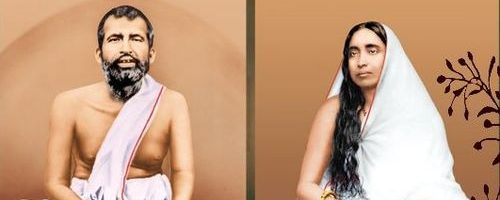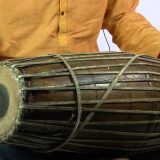Saareeraka Upanishad~7(A)
SriSaaradaa Vaatsalya Deeptih :—
03—01—2018; Wednesday.
Aarsha Saaradaa. Saareeraka Upanishad~7(A).
We received a wonderful suggestion from Smt. B. Sahiti-Chennai that we may have an elucidation on the import of the Mantra:14.
There is a marvellous name of Sri Lalitaa Parameswari in “Sri Lalitaa Sahasranaama Stotram”. It is
“Pancha kritya Paraayanaa” (274).
This Holy Name of the Divine Mother is preceded by ten miraculous Names Which can be arranged into five sets of two each.
- Srishti kartree—Brahma roopaa.
- Goptree—Givinda roopinee.
- Samhaarinee—Rudra roopaa.
- Tirodhaana karee—Eeswaree.
- Anugrahadaa—Sadaasivaa.
Unless one is thoroughly well acquainted with the concepts of Kaasmeera Siva Advaita philosophy, one can not possibly understand the actual significance of the eleven names of Sri Lalitaadevi (Names from 264 to 274, both inclusive, of the text of this Sahasranaama stotram).
Sri Lalitaadevi performs all these activities of creation(srishti) in the form of Creative Force of the Creator(Brahma), protection(sthiti) in the form of Protective Force of the Protector(Sri Maha Vishnu), destruction(samhaara) in the form of Destructive Force of the Destroyer(Rudra), total withdrawal(tirodhaana) in the form of the Withdrawal Force of the Withdrawer(Eeswara), and extending unqualified and illimitable grace(anugraha) in the form of the Force of All-encompassing-Absolute Grace and All-abounding Auspiciousness –bestower (Sadaasiva).
For our present purpose, the first three, namely, creation, sustenance and withdrawal are being taken up for our discussion.
In one of the Kaasmeera Siva Advaita standard texts, “Pratyabhijnaa Hridayam” of Kshemaraja, one of the prime teachers of K.S.A., it is declared as under, in the aphorism: 5.
“Chitih eva Chetana padaat Avaroodhaa Chetya
Sankochinee Chittam” ||
“Universal Consciousness, called as Chiti, Herself having descended from the state of the unconstricted Consciousness, known as Chetana, becomes constricted as individual consciousness, named as Chittam. Consequently, in the form of Chittam, She Herself becomes constricted as Snkochini, conforming to the objects of consciousness called chetya“.
Now it is clear that all of us, as the children of the Divine Mother, acquire all Her qualities in a restricted manner. To this effect there is an aphorism in the text. Its number is 10 which declares to us the same thing. It is as under:—
“Tathaapi Tadvat pancha krityaani karoti” ||
“Even in this constricted condition of individual identity, the individual human being performs the five activities called srishti, sthiti, samhaara, tirodhaana and anugraha as does the Supreme Reality“.
So, with this understanding at the back of our mind, let us try to expound on the aspects of the three components of creation, protection or sustenance and withdrawal as are being done by us in the capacity of individual human beings.
Let us confine our discussion to our individual activity in a single day as a representative sample of our life-time activities.
When we wake up from our sleep in the early morning, we create our day with our wakefulness. All the daily activity is the sustenance process itself. When we enter into deep sleep, all our activities including our wakefulness-consciousness withdraw into our deep sleep state. In a general way, this is more or less a rough sketch of our routine life.
Now we discuss the creation and the sustenance aspects of human existence, both of which inescapably presuppose the fundamental element of “space”. Without space nothing can be created including all the human arts. This is the cardinal precondition. That is why the Taittireeya upanishad states as under:
“Tasmaat vaa etasmaat Aatmanah aakaasah
sambhootah” || (T.U.: II— i —1).
“From that or this Aatma the space-element came out“.
When creation took place it did not happen all of a sudden. The creation of universe evolved step by step according to the sages of the upanishad. For the generation of the diverse universe, firstly, space is produced in order to accommodate every thing in the creation.
The same way, human creation also presupposes the existence of space. This human creativity is both objective and subjective. The objective creation is the result of the subjective principle of human creativity. As there is an objective space, outwardly, to take hold of the objective creations of man, same way concomitantly, there should be a subjective space, inwardly, to accommodate the subjective ideas, feelings and other innumerable emotions and inner activities of a human being.
So, the external space is called the “jada aakaasa” or the inert or inanimate space and the inner space is termed as “Chit Aakaasa“, the space of consciousness. In this space of consciousness all individual ideas, thoughts, feelings and so on take shape, conditioned by one’s own individual tendencies governed by karmic accumulations of the individual which play a pivotal role in delineating completely individualistic and defining characteristics.
Swasti ||














Superb sir. I don’t have words to explain my immense pleasure. I request, for a layman and novice like me, kindly use the simplistic possible vocabulary.
Thank you thank you very much.i am able to get some clarity.wonderful explanation given by you “subjective and objective creations.”
And Devi’s those 10″namas”.
As per my brain’s very limited perceptive capacity, I feel that “Akash thathvam” is like a stage.it leads us to “chidambaram” too.
When you say “the constricted qualitis of Devine mother”,I imagine we human beings rolling down from “her” lap straight in to the “Maya” net.
But pity is how strong our karma!we won’t look up.going deep and deep.struggle not to get out but get still more downwards.
I request you to elaborate on some more topics.
Like a mathematical derivation the space concept
has been explained step by step, quoting various
sources. It means that one can understand
Upanishads only when he is acquainted with various
Scriptures and Sastras. That is why they are to be
studied under the guidance of Masters like you.